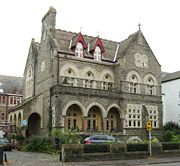
Park House, Cardiff
Encyclopedia

Cardiff
Cardiff is the capital, largest city and most populous county of Wales and the 10th largest city in the United Kingdom. The city is Wales' chief commercial centre, the base for most national cultural and sporting institutions, the Welsh national media, and the seat of the National Assembly for...
. It was built for James McConnochie, Chief Engineer to the Bute Docks, by the Gothic revivalist
Gothic Revival architecture
The Gothic Revival is an architectural movement that began in the 1740s in England...
architect William Burges
William Burges (architect)
William Burges was an English architect and designer. Amongst the greatest of the Victorian art-architects, Burges sought in his work an escape from 19th century industrialisation and a return to the values, architectural and social, of an imagined mediaeval England...
. It is a Grade I listed building. "By its powerful early French Gothic style, its steep roofs and boldly textured walls (the house) revolutionized Cardiff
Cardiff
Cardiff is the capital, largest city and most populous county of Wales and the 10th largest city in the United Kingdom. The city is Wales' chief commercial centre, the base for most national cultural and sporting institutions, the Welsh national media, and the seat of the National Assembly for...
's domestic architecture."
Commissioned by McConnochie in 1871, the house was completed externally by 1874, although decoration of the interior continued, somewhat slowly, until McConnochie's Cardiff mayoral year of 1880. The house was much admired at the time of its construction, being referenced by Viollet-le-Duc
Eugène Viollet-le-Duc
Eugène Emmanuel Viollet-le-Duc was a French architect and theorist, famous for his interpretive "restorations" of medieval buildings. Born in Paris, he was a major Gothic Revival architect.-Early years:...
and its plans displayed at the Royal Academy
Royal Academy
The Royal Academy of Arts is an art institution based in Burlington House on Piccadilly, London. The Royal Academy of Arts has a unique position in being an independent, privately funded institution led by eminent artists and architects whose purpose is to promote the creation, enjoyment and...
. Today, the house is of particular interest for three reasons; as the precursor of Burges' own house in Kensington, as evidence of one of the few architectural errors Burges made in his career and as a template for an architectural style which had a significant influence on late Victorian/Early Edwardian Cardiff.
The style of the house is Burges' signature Early French Gothic, with triangle and rectangle to the fore, although it is without the conical tower felt appropriate for Burges' own home and for Castell Coch
Castell Coch
Castell Coch is a 19th-century Gothic Revival castle built on the remains of a genuine 13th-century fortification. It is situated on a steep hillside high above the village of Tongwynlais, to the north of Cardiff in Wales, and is a Grade I listed building as of 28 January 1963.Designed by William...
. The external frontage comprises four gables, the windows of the last gable concealing the major error of the interior, the fact that the entrance confronts the visitor with the underside of a colossal staircase,. It is hard to understand how Burges could have made such a mistake. It was not repeated at The Tower House
The Tower House
The Tower House is a late-Victorian town house, built between 1876 and 1878 in the 13th century French gothic style, by the Victorian art-architect William Burges for himself...
, which is an almost, reversed, replica, with added conical tower. The style of the house was widely imitated, in Cardiff and beyond and this can be evidenced by walking tours of any of Cardiff's inner suburbs, where faint and not so faint traces of Burges' influence can be seen. Cadw
Cadw
-Conservation and Protection:Many of Wales's great castles and other monuments, such as bishop's palaces, historic houses, and ruined abbeys, are now in Cadw's care. Cadw does not own them but is responsible for their upkeep and for making them accessible to the public...
described Park House as "perhaps the most important 19th century house in Wales".
Burges used various building stones for Park House, Pennant Sandstone for the walls, Bath stone
Bath Stone
Bath Stone is an Oolitic Limestone comprising granular fragments of calcium carbonate. Originally obtained from the Combe Down and Bathampton Down Mines under Combe Down, Somerset, England, its warm, honey colouring gives the World Heritage City of Bath, England its distinctive appearance...
s around the windows, entrance porch and plinths, while the pillars are pink Peterhead granite
Granite
Granite is a common and widely occurring type of intrusive, felsic, igneous rock. Granite usually has a medium- to coarse-grained texture. Occasionally some individual crystals are larger than the groundmass, in which case the texture is known as porphyritic. A granitic rock with a porphyritic...
from Aberdeenshire.
The house is now a private members' club.

